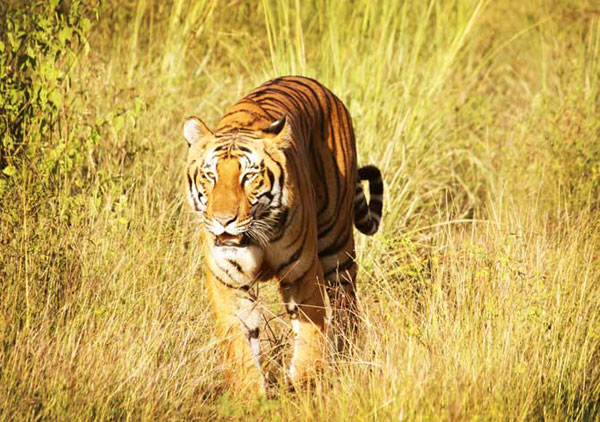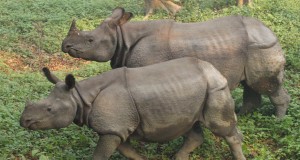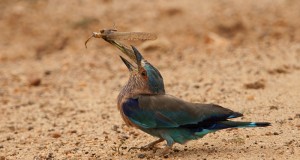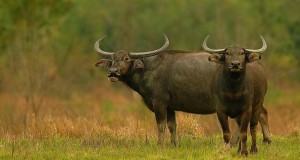Just short of 300 km northeast of Delhi, cradled in the foothills of the Himalaya lies the Corbett National Park. It is India’s first national park and also one of her finest. This park has quite a history. Long ago, on the banks of the river Ramganga, there lived a flourishing community. Today, some evidence of their culture is found in fragments of terra-cotta and the remains of their temples along the river. This community lived by clearing some of the forest in the duns (valleys) and had to fight a constant battle to keep their farmlands free from the invading jungle.
The First in a Series: The 40 years following the arrival of the British in this area in 1820 were disastrous. Trees were felled mercilessly for timber and these virgin forests were devastated. It was a Major Ramsay who 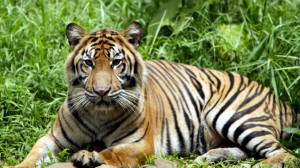 took the first real systematic measures which, in years to follow, were to restore the forests to their former health. Cattle stations were removed, cultivation was stopped, a fire-lighting force was established and, most important, the removal ofti mber without a license was totally prohibited. Then, in 1907, the possibility of creating a game sanctuary in this area was first mooted, but was rejected outright. Two forest officers, E.R. Stevens and his successor, E.A. Smythies, were to take up this cause again. However, it was only later, when Smythies was conservator that he consulted Major Jim Corbett who knew this area well, regarding the possible boundaries for a proposed national park.
took the first real systematic measures which, in years to follow, were to restore the forests to their former health. Cattle stations were removed, cultivation was stopped, a fire-lighting force was established and, most important, the removal ofti mber without a license was totally prohibited. Then, in 1907, the possibility of creating a game sanctuary in this area was first mooted, but was rejected outright. Two forest officers, E.R. Stevens and his successor, E.A. Smythies, were to take up this cause again. However, it was only later, when Smythies was conservator that he consulted Major Jim Corbett who knew this area well, regarding the possible boundaries for a proposed national park.
During the 1930s, tiger shooting was in vogue and many a viceroy, governor-general and other dignitary visited this area — the famous terai and bhabar tracts of the then United Provinces — to bag their tigers from elephant-back and high machans in elaborate tamashas (entertainments): tiger shoots. However, it was through the efforts of other hunters, the true conservationists, who abhorred this form of sport and massacre, that Sir Malcolm Hailey, then Governor of the United Provinces, keenly accepted the recommendation that an area of 99.07 sq miles (256.59 sq km) be set aside for the park. Thus, on Aug. 8, 1936, the Hailey National Park, India’s first, was established.
Tribute to an Enlightened Hunter: In 1952, a few years after India attained independence, the park’s name was changed to Ramganga National Park, after the lifegiving Ramgariga river that flows through almost the whole length of it. In 1957, it was renamed once more, Corbett National Park, in honor and memory of the late Jim Corbett, the legendary, hunter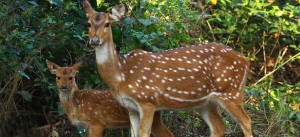 -naturalist turned author and photographer who had helped in demarcating the park’s boundaries and setting it up. It was in this area that he had shot the dreaded “maneaters,” the notorious Kanda Maneater being one of them. His books on these thrilling, true-life adventures, The Maneaters of Kurnaon and The Maneating Leopard of Ructraprayag , are perennial best-sellers, well-known all over the world.
-naturalist turned author and photographer who had helped in demarcating the park’s boundaries and setting it up. It was in this area that he had shot the dreaded “maneaters,” the notorious Kanda Maneater being one of them. His books on these thrilling, true-life adventures, The Maneaters of Kurnaon and The Maneating Leopard of Ructraprayag , are perennial best-sellers, well-known all over the world.
The man who had influenced Jim Corbett most to hang up his guns and take to the camera was a forest officer, F. W. Champion, the pioneer of wildlife photography in India. His masterpieces, With a Camera in Tiger-land and The Jungle in Sunlight and Shadow, were photographed and written in these very same jungles.
In the late 1960s and the early 1970s, the world was hit by the awareness that the Indian tiger (Panther tigris tigris) was on the brink of extinction and that of an estimated 40,000 at the turn of the century, less than 2000 survived in the wild. A reaching project was envisaged. Its philosophy was that, if the tiger and its habitat were totally protected in tiger reserves, then other species of fauna and flora too would flourish as nature would maintain her own balance. Thus, with the help of the World Wildlife Fund, Project Tiger was launched at Dhikala in the Corbett National Park on Apr. I, 1973. This National Park was one of the first tiger reserves along with seven others in the country; today, there are 15 such reserves. The tiger census for 1984 reveals that there are now 4005 tigers in India.
Topography: The Corbett National Park or just “Corbett” as it is also popularly known is situated in the hilly districts of Pauri Garhwal and Nainital of the northern state of Uttar Pradesh. It lies between latitude 29° 13′ North and 29° 35′ North and longitude 78° 33′ East and 78° 46′ East. The park co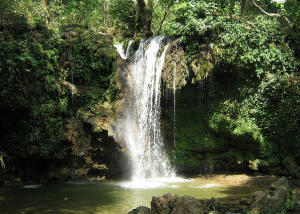 mprises an area of 201 sq miles, (520.6 sq km). Of this, an area of 123.5 sq miles(320 sq km) is the core — the sanctum sane Forum, where no kind of disturbance is permitted. There is a move to expand the park by another 425 sq miles (1100 sq km). However, at the time of writing, only an area of 116 sq miles (300 sq km) is to be added immediately to the northern area of the park. This expansion is keenly sought after by conservationists as it will link the park with other forests through corridors. This is important to help the overflow of animals to level out, prevent inbreeding and ensure that viable gene pools are Maintained.
mprises an area of 201 sq miles, (520.6 sq km). Of this, an area of 123.5 sq miles(320 sq km) is the core — the sanctum sane Forum, where no kind of disturbance is permitted. There is a move to expand the park by another 425 sq miles (1100 sq km). However, at the time of writing, only an area of 116 sq miles (300 sq km) is to be added immediately to the northern area of the park. This expansion is keenly sought after by conservationists as it will link the park with other forests through corridors. This is important to help the overflow of animals to level out, prevent inbreeding and ensure that viable gene pools are Maintained.
The area in the Himalayan foothills in which the park is situated is known as the South Patlidun. In elevation the park ranges between 1312 feet (400 meters) at its lowest to 3970 feet (1210 meters) at its highest. Corbett is, in fact, a large valley with its long axis from east to west. Through this valley run three thickly forested ridge systems roughly parallel to one another and in the same direction. Small offshoots of these ridges run north to south and the valleys formed in between are known as sots. The ridge to the north forms the boundary of the park in that direction and Kanda, the highest point, with its magnificent panoramic view of the park is here.
Between the northern ridge and the median ridge which is the longest is the Ramganga river, which enters the park from the northeast, flows through the park into the reservoir and makes its exit at Kalagarh towards the southwest. The southern ridge is a bit lower and this area of the park is drier and is notable for its more deciduous type of vegetation and its own rugged cha rm. A topographic change of significance that took place in the park was the inundation of 16 sq miles (42 sq km) of prime habitat when almost a tenth of the park’s area was lost to the waters of a multipurpose hydel dam at Kalagarh. This is the largest carthern dam in Asia and lies at the southwestern fringe of Corbett. The construction of the dam certainly was not in the best interest of the park. Conservationists had feared that the changes that would come with such a dam would bring about adverse effects but the changes by and large have been absorbed by the remarkable resilience of nature.
rm. A topographic change of significance that took place in the park was the inundation of 16 sq miles (42 sq km) of prime habitat when almost a tenth of the park’s area was lost to the waters of a multipurpose hydel dam at Kalagarh. This is the largest carthern dam in Asia and lies at the southwestern fringe of Corbett. The construction of the dam certainly was not in the best interest of the park. Conservationists had feared that the changes that would come with such a dam would bring about adverse effects but the changes by and large have been absorbed by the remarkable resilience of nature.
The waters first started to fill up in 1974. In 1976, when they had inundated a greater part of the reservoir, the elephant migration routes linking the park with the western and northwestern reserved forests were cut off. Not for long though. Those great, accomplished surveyors of gradients and trailblazers soon established other routes. There was a shift of animals from the affected areas to higher ground. There will also be changes that are less apparent at this stage and though some research has been done, much more is needed and is planned to study these changes in detail. The lake, besides just its scenic charm, has added to the park in a few ways. A large number of species of water birds, both migrants and others, have begun to frequent its waters, though mainly in winter. Crocodiles — both the long-snouted, fish-eating gharial (Gavials gangelicus ) and the mugger (Crocodylus palustris) have found new homes here and their numbers have increased. They can often be seen sunning themselves on the sand banks.
For anglers too the lake is a paradise. Sporting fish such as the mahseer (Barhus tor) and malee ( Wallah attu), abound in the lake and in the river. The maser is a well-known fighting fish. Fishing with rod and line is allowed if a permit is first obtained. Fishing in the river, however, offers greater pleasure as well as good exercise to the sportsman who is called upon to pit his skill to outwit the mighty maser. The lake offers better fishing perhaps, but lacks the thrill and sport of the river.
Flora and Climate: Vegetation in the park is confined chiefly to the Sahara tract type of the Siwalik hills; different kinds of vegetation are found a ll along the varied topography, which comprises hilly and riverain areas, temporary marshy depressions, plateaus and ravines. The park is known for its almost pure sal (Chorea rohusta) stands in the lower hilly ridges and flat valleys. Some associates of sal here are haldu (Adira cordifolia), rohini (Mallets plulippinensis), and karipak (Murrain konigi).The riverain area is clothed in shisham (Daihergia sissoo), khair (Acacia catch ) and others. In early summer it’s an unforgettable sight to witness the soothing green of the shisham islands in new leaf.
ll along the varied topography, which comprises hilly and riverain areas, temporary marshy depressions, plateaus and ravines. The park is known for its almost pure sal (Chorea rohusta) stands in the lower hilly ridges and flat valleys. Some associates of sal here are haldu (Adira cordifolia), rohini (Mallets plulippinensis), and karipak (Murrain konigi).The riverain area is clothed in shisham (Daihergia sissoo), khair (Acacia catch ) and others. In early summer it’s an unforgettable sight to witness the soothing green of the shisham islands in new leaf.
On the higher ridges we find bakli (Anogeissus Iatifolia) which enriches the hues of the park with its reddish leaves and pale bark. The chir (Pinus roxhurghii ), anauri (Legesiroemia paruiflora), and gurail (Bauhinia racemosa) are some others that find root-holds at these contours, along with bamboos. The common shrub is Clerodendrum viscasum and a weed which is causing some concern is the lantana.
The ehaurs, the savannah grasslands, are covered with a variety of grasses like Themeda arundinacea, Vetiveria zizanioides and Thysanulena maxima.
A hundred and ten species of trees, 51 species of shrubs and over 33 species of bamboo and grass are found here.
There are three distinct seasons in Corbett: Cold — November to February; Hot – – March to June; Rainy (Monsoons) July to October. In winter the nights are cold at an average of 41°F (5°C), with frost and some fog which lasts till late morning, but the sun is pleasant and the day temperature averages 77°F (25°C). In the hot season, June is the hottest month, with day temp eratures going up to an unbearable 112°F (44°C) but the nights are pleasant with an average temperature of 70°F (21°C). In the monsoon season, from June to October, the park remains closed to tourists. There is very heavy rain, between 60 inches and 112 inches (1500 mm and 2800 mm). The roads are washed away by the heavy downpours and when the sun does shine the jungle steams with humidity. The animals move to the hilly areas of Corbett at this time for the cool breeze and to avoid the daans, a blood-sucking fly, which plagues them in the lowlands. Surely, these few months are times of a well deserved rest from the attentions of man for the denizens of the jungle.
eratures going up to an unbearable 112°F (44°C) but the nights are pleasant with an average temperature of 70°F (21°C). In the monsoon season, from June to October, the park remains closed to tourists. There is very heavy rain, between 60 inches and 112 inches (1500 mm and 2800 mm). The roads are washed away by the heavy downpours and when the sun does shine the jungle steams with humidity. The animals move to the hilly areas of Corbett at this time for the cool breeze and to avoid the daans, a blood-sucking fly, which plagues them in the lowlands. Surely, these few months are times of a well deserved rest from the attentions of man for the denizens of the jungle.
Rich Variety: Over 50 mammal, 580 bird and 25 reptile species have been listed in Corbett. The insect life in itself is astounding and though not much work has been done in this respect even the layman will be amazed at its abundance, mainly after the monsoon.
Corbett is well-known and a haven for its tigers. There is plentiful prey — four kinds of deer, wild boar and other lesser animals — for them to live on. With a bit of luck, it’s possible to see a tiger on the road as you enter the park and motor down to Dhikala. Pug marks are seen in abundance on the roadsides, paths and animal trails. It’s by tracing these pug marks, which bear individual characteristics, that the estimated population, which has shown a marked increase from 40 in 1972 to 90 tigers in 1984, is known.
Leopards ( Panthera pardus) are found in the hilly areas of the park. They do someti mes venture into the lower jungles but at much risk to themselves from tigers. There have been many cases of leopards being killed and eaten by tigers. The leopard is, however, a great survivor and can sustain itself on e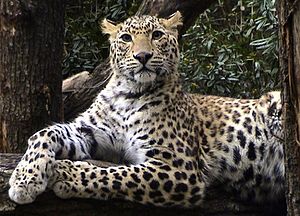 ven small birds and rodents. The lesser cats such as the leopard cat ( Fells bengalensis horsfieldi), the jungle cat (Fesis chaus), the rare fishing cat (Felis viverina) and some others are found here, but being nocturnal are rarely seen. The sloth bear ( Melursus ursinus) is found in the Bijrani-Malani areas of the park. It can be seen on the roadsides in the early morning or late evening, busily demolishing termite mounds for the grubs, or in the mahwa ( Madhura indica) trees, relishing the sweet sticky flowers, which ferment in the hot season and are intoxicating. The Himalayan black bear (Selenarcrtos thibetanus) is seen in the higher hills towards Kanda but only rarely and that too in the cold winters.
ven small birds and rodents. The lesser cats such as the leopard cat ( Fells bengalensis horsfieldi), the jungle cat (Fesis chaus), the rare fishing cat (Felis viverina) and some others are found here, but being nocturnal are rarely seen. The sloth bear ( Melursus ursinus) is found in the Bijrani-Malani areas of the park. It can be seen on the roadsides in the early morning or late evening, busily demolishing termite mounds for the grubs, or in the mahwa ( Madhura indica) trees, relishing the sweet sticky flowers, which ferment in the hot season and are intoxicating. The Himalayan black bear (Selenarcrtos thibetanus) is seen in the higher hills towards Kanda but only rarely and that too in the cold winters.
The dhole ( Cuon aspinus), the wild dog, is also rare and seen in the southern areas of Corbett towards Bijrani. The jackal ( Canis aureus) is commonly seen around all the campus areas. During the fawning season, jackals are most active and can be seen killing and carrying off newly dropped chital fawns.
The yellow-throated marten ( Mantes Jlavicula .Jlavicula), the Himalayan palm civet ( Paguma sarvata graji ), the Indian gray mongoose ( Herpestes towards), the common otter ( Sutra sutra monticosa) and the blacknaped hare (Sepus nigricollis ruficaudatus) are some of the smaller resident mammals. The porcupine (Hystrix indica) can also be seen at night near the garbage dumps of the campus at Dhikala.
Elephants ( Esephas maxims ) are one of the main attractions of Corbett. The whole jungle belongs to them. It is possible to see a herd or even a lone tusker crossing the road. Corbett’s elephants by and large are well behaved, but one must always remember that, “Elephants have the right of way.” 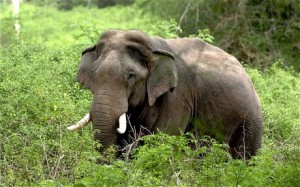 The park’s elephant population varies from about 200 to 300 and more in summer, when the sub-herds amalgamate and form large herds.Of the four species of deer that are found here are the chital (Axis axis), the wellknown spotted deer and considered one of the most beautiful in the world. This is one of the chief prey animals of the carnivora. A smaller cousin of the chital, the para (Axis porcimis) is found in the more open grassland and rivcrain areas. The sambar ( Cervus unicolor) is the largest Asiatic deer and is sought after by the larger adult tigers of the park. The kakkar (Munuacus munijak), also called the barking deer, is the smallest of the four. Nervous and shy, it warns the jungle’s denizens of danger with its hoarse, dog-like bark.
The park’s elephant population varies from about 200 to 300 and more in summer, when the sub-herds amalgamate and form large herds.Of the four species of deer that are found here are the chital (Axis axis), the wellknown spotted deer and considered one of the most beautiful in the world. This is one of the chief prey animals of the carnivora. A smaller cousin of the chital, the para (Axis porcimis) is found in the more open grassland and rivcrain areas. The sambar ( Cervus unicolor) is the largest Asiatic deer and is sought after by the larger adult tigers of the park. The kakkar (Munuacus munijak), also called the barking deer, is the smallest of the four. Nervous and shy, it warns the jungle’s denizens of danger with its hoarse, dog-like bark.
The goat-antelopes are represented by the ghoral ( Nemorhaedus goral) in Corbett. Ghorals can be spotted on a drive up the hilly road to Kanda. Wild boar ( Sus scrofa) are found in the forests as well as in the grasslands, someti mes seen in sounders of 10 to 30 pigs. Even the tigers respect the large male boars. In encounters sometimes, tigers are known to have been killed by a large male wild boar. The langur (Presbytis entellus) and the rhesus (Maraca mulaita) are well distributed throughout the park and also warn the jungle with their alarm calls, when they see either tiger or leopard from their tree-top perches.
Avian Attractions: Corbett has many attractions for the bird watcher also. Over 580 species of birds are found here. Most of the water birds are migrants and arrive in • winter. Some of these are the greylag and the barheaded goose, ducks of many kinds, and great crested grebe, snipe, sandpiper, plover, gull and wagtail. Some of the residents are darters, cormorants, egrets, herons, the blacknecked stork and the spurwinged lapwing. The commonly seen rapto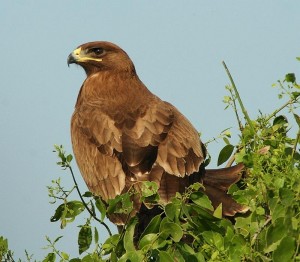 rs in Corbett are the osprey, crested serpent eagle, blackwinged kite, shikra, Pallas’s fishing eagle, gray headed fishing eagle, spotted eagle and harrier. Some of the other birds found in the forests are minivets, shrikes, babblers, doves, bongos , cuckoos, parakeets, barbels, 17 kinds of woodpecker, thrushes, peafowl, kalij pheasants and red junglefowl — the ancestor of all domestic fowl. The rare chir pheasant is found in the higher hills near Kanda. The vultures commonly found are the Indian white-backed, Himalayan longbilled and the king or black vulture. On elephant rides, the mahouts keep a wary eye open for the circling vultures as they help pinpoint a carnivora’s kill.
rs in Corbett are the osprey, crested serpent eagle, blackwinged kite, shikra, Pallas’s fishing eagle, gray headed fishing eagle, spotted eagle and harrier. Some of the other birds found in the forests are minivets, shrikes, babblers, doves, bongos , cuckoos, parakeets, barbels, 17 kinds of woodpecker, thrushes, peafowl, kalij pheasants and red junglefowl — the ancestor of all domestic fowl. The rare chir pheasant is found in the higher hills near Kanda. The vultures commonly found are the Indian white-backed, Himalayan longbilled and the king or black vulture. On elephant rides, the mahouts keep a wary eye open for the circling vultures as they help pinpoint a carnivora’s kill.
The nocturnal birds are the nightjars, thick-knees, owls and owlets and, by the river, the great stone plover and stone curlew hunt at night. Reptiles: The Ramganga is the home of the descendants of the prehistoric reptiles, the gharial and the mugger. The gharial is the rare fish-eating, long-nosed crocodile, only just saved from extinction in the park through captive breeding and release to augment the few survivors there. A few species of turtles and tortoises are also found in and around the lake.
The Indian python, viper, cobra, krait and king cobra, the largest of poisonous snakes, also inhabit Corbett, as do monitors and other lesser lizards. Facilities: The park is open from November 15 to June 15. The best time to visit it depends on one’s priorities of interests. For wildlife photography, the best months are April to June.
There are many Forest Rest Houses in Corbett which can be reserved in advance. These arc situated in picturesque areas of the park. For the more adventurous and serious-minded wildlifers, photographers, anglers, and those who just want to be in the jungle, these undisturbed locations are invaluable. In most o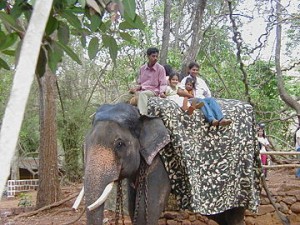 these rest houses, the basics are provided but one has to carry one’s own food and it’s always wise to take a sleeping bag along too. It is also advantageous to have one’s own vehicle here. At some of these locations, elephants for wildlife viewing are stationed. Walking in some areas is permitted, but only when accompanied by a guide.
these rest houses, the basics are provided but one has to carry one’s own food and it’s always wise to take a sleeping bag along too. It is also advantageous to have one’s own vehicle here. At some of these locations, elephants for wildlife viewing are stationed. Walking in some areas is permitted, but only when accompanied by a guide.
The Dhikala Complex, which at the moment draws most of the visitors, caters in full to all the needs of various budgets. Dhikala is a very picturesque location indeed, and the areas around it, including the famous Dhikala Chaur, abound in wildlife. Elephant rides for wildlife viewing in the mornings and evenings can be booked here. This form of transport for wildlife viewing is the best as the visibility is excellent and a silent and close approach to wild animals is possible. It is also possible to view wildlife from one’s car with a guide. A motor vehicle certainly causes less disturbance to the animals than man on foot.

